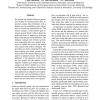Free Online Productivity Tools
i2Speak
i2Symbol
i2OCR
iTex2Img
iWeb2Print
iWeb2Shot
i2Type
iPdf2Split
iPdf2Merge
i2Bopomofo
i2Arabic
i2Style
i2Image
i2PDF
iLatex2Rtf
Sci2ools
INLG
2010
Springer
2010
Springer
Situated Reference in a Hybrid Human-Robot Interaction System
We present the situated reference generation module of a hybrid human-robot interaction system that collaborates with a human user in assembling target objects from a wooden toy construction set. The system contains a sub-symbolic goal inference system which is able to detect the goals and errors of humans by analysing their verbal and non-verbal behaviour. The dialogue manager and reference generation components then use situated references to explain the errors to the human users and provide solution strategies. We describe a user study comparing the results from subjects who heard constant references to those who heard references generated by an adaptive process. There was no difference in the objective results across the two groups, but the subjects in the adaptive condition gave higher subjective ratings to the robot's abilities as a conversational partner. An analysis of the objective and subjective results found that the main predictors of subjective user satisfaction were...
Human Users | INLG 2010 | Natural Language Processing | Reference Generation | Situated References |
| Added | 13 Feb 2011 |
| Updated | 13 Feb 2011 |
| Type | Journal |
| Year | 2010 |
| Where | INLG |
| Authors | Manuel Giuliani, Mary Ellen Foster, Amy Isard, Colin Matheson, Jon Oberlander, Alois Knoll |
Comments (0)

